Analyzing PR Effectiveness: Relations and Evaluation in Healthcare
VerifiedAdded on 2023/06/04
|15
|4571
|373
Essay
AI Summary
This essay explores the effectiveness of public relations (PR) and media relations, focusing on the criteria for evaluating PR's impact on organizational decision-making and goal attainment. It emphasizes the hierarchical nature of PR results, multiplicity, and the integration of PR effectiveness at different organizational levels. Key elements of PR evaluation, such as objectives, communication quality, outputs, outtakes, and outcomes, are examined. A case study of Australia's NHS Blood and Transplant 'Gift of Life' campaign is presented, analyzing its PR strategies to increase donor numbers. The evaluation covers the campaign's objectives, strategies (social media, press releases, events), and the challenges faced in achieving desired outcomes, highlighting the importance of effective PR in public health.
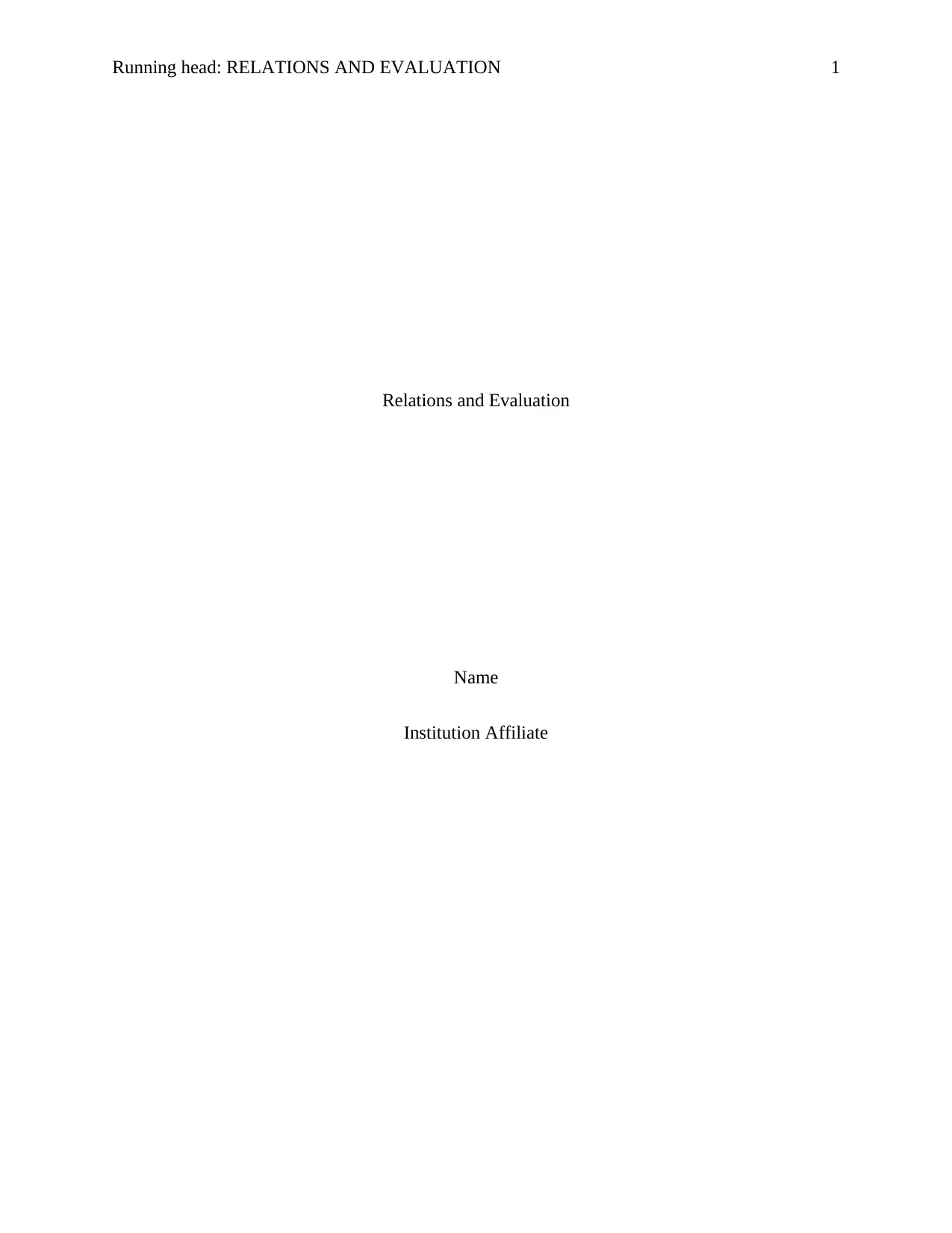
Running head: RELATIONS AND EVALUATION 1
Relations and Evaluation
Name
Institution Affiliate
Relations and Evaluation
Name
Institution Affiliate
Paraphrase This Document
Need a fresh take? Get an instant paraphrase of this document with our AI Paraphraser
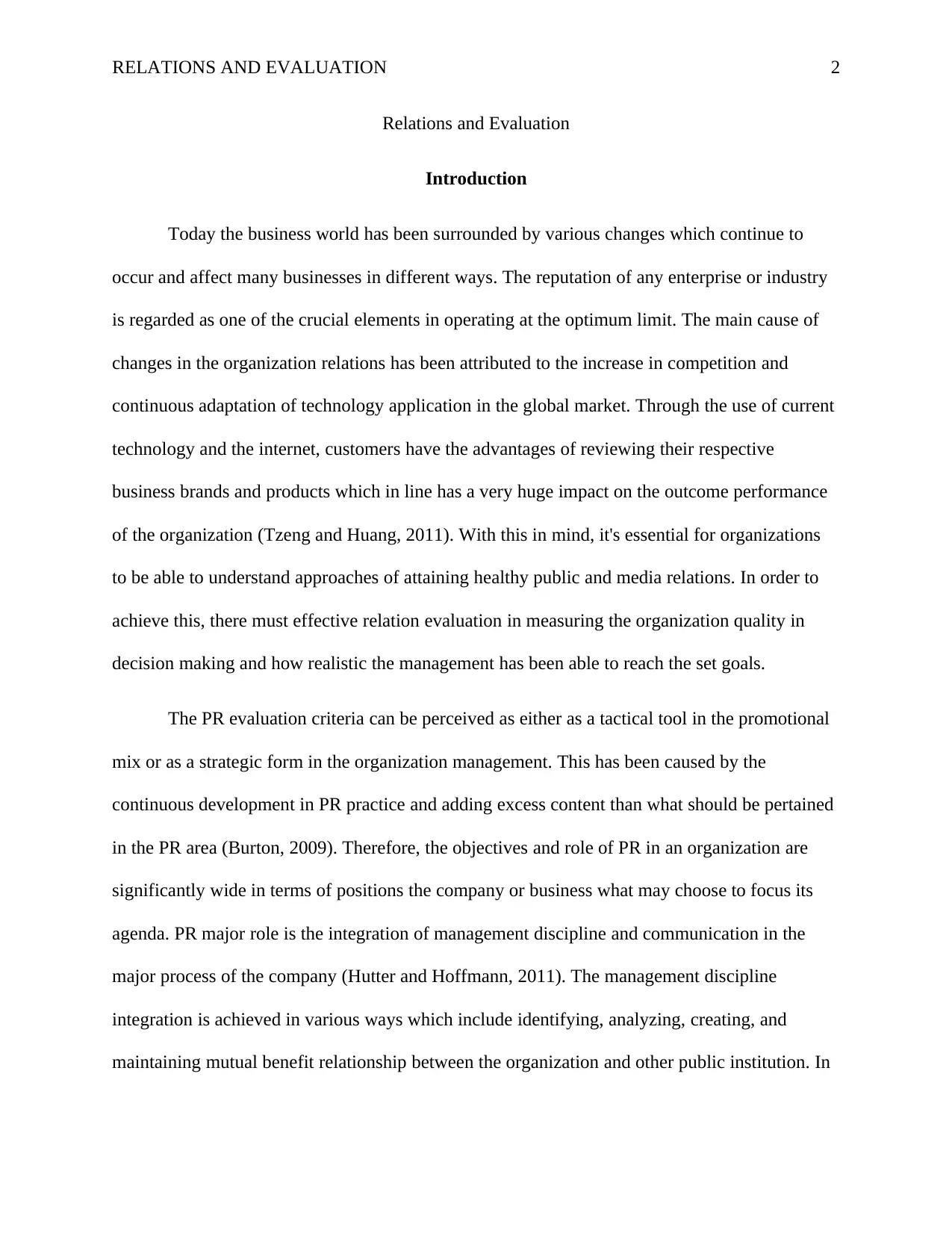
RELATIONS AND EVALUATION 2
Relations and Evaluation
Introduction
Today the business world has been surrounded by various changes which continue to
occur and affect many businesses in different ways. The reputation of any enterprise or industry
is regarded as one of the crucial elements in operating at the optimum limit. The main cause of
changes in the organization relations has been attributed to the increase in competition and
continuous adaptation of technology application in the global market. Through the use of current
technology and the internet, customers have the advantages of reviewing their respective
business brands and products which in line has a very huge impact on the outcome performance
of the organization (Tzeng and Huang, 2011). With this in mind, it's essential for organizations
to be able to understand approaches of attaining healthy public and media relations. In order to
achieve this, there must effective relation evaluation in measuring the organization quality in
decision making and how realistic the management has been able to reach the set goals.
The PR evaluation criteria can be perceived as either as a tactical tool in the promotional
mix or as a strategic form in the organization management. This has been caused by the
continuous development in PR practice and adding excess content than what should be pertained
in the PR area (Burton, 2009). Therefore, the objectives and role of PR in an organization are
significantly wide in terms of positions the company or business what may choose to focus its
agenda. PR major role is the integration of management discipline and communication in the
major process of the company (Hutter and Hoffmann, 2011). The management discipline
integration is achieved in various ways which include identifying, analyzing, creating, and
maintaining mutual benefit relationship between the organization and other public institution. In
Relations and Evaluation
Introduction
Today the business world has been surrounded by various changes which continue to
occur and affect many businesses in different ways. The reputation of any enterprise or industry
is regarded as one of the crucial elements in operating at the optimum limit. The main cause of
changes in the organization relations has been attributed to the increase in competition and
continuous adaptation of technology application in the global market. Through the use of current
technology and the internet, customers have the advantages of reviewing their respective
business brands and products which in line has a very huge impact on the outcome performance
of the organization (Tzeng and Huang, 2011). With this in mind, it's essential for organizations
to be able to understand approaches of attaining healthy public and media relations. In order to
achieve this, there must effective relation evaluation in measuring the organization quality in
decision making and how realistic the management has been able to reach the set goals.
The PR evaluation criteria can be perceived as either as a tactical tool in the promotional
mix or as a strategic form in the organization management. This has been caused by the
continuous development in PR practice and adding excess content than what should be pertained
in the PR area (Burton, 2009). Therefore, the objectives and role of PR in an organization are
significantly wide in terms of positions the company or business what may choose to focus its
agenda. PR major role is the integration of management discipline and communication in the
major process of the company (Hutter and Hoffmann, 2011). The management discipline
integration is achieved in various ways which include identifying, analyzing, creating, and
maintaining mutual benefit relationship between the organization and other public institution. In
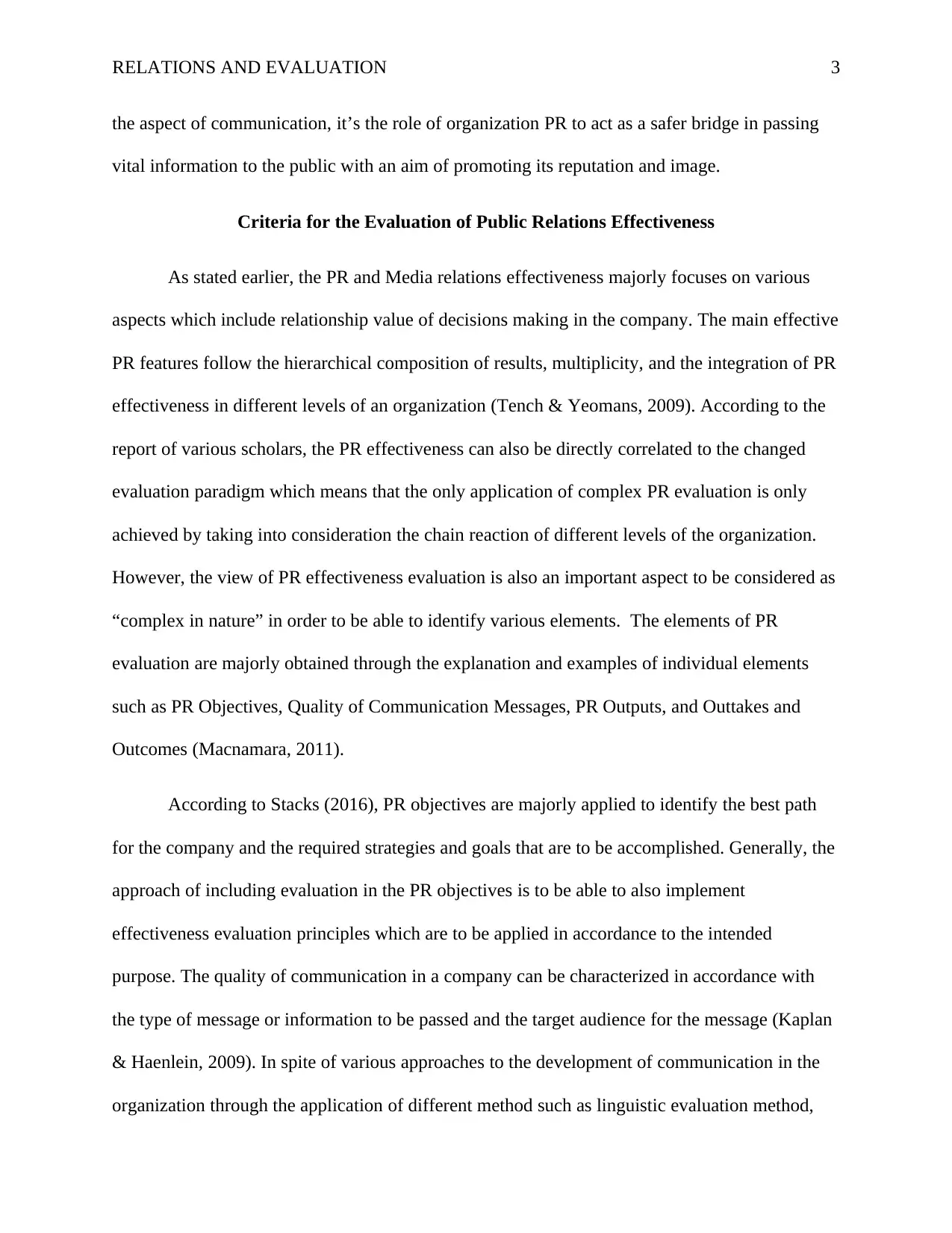
RELATIONS AND EVALUATION 3
the aspect of communication, it’s the role of organization PR to act as a safer bridge in passing
vital information to the public with an aim of promoting its reputation and image.
Criteria for the Evaluation of Public Relations Effectiveness
As stated earlier, the PR and Media relations effectiveness majorly focuses on various
aspects which include relationship value of decisions making in the company. The main effective
PR features follow the hierarchical composition of results, multiplicity, and the integration of PR
effectiveness in different levels of an organization (Tench & Yeomans, 2009). According to the
report of various scholars, the PR effectiveness can also be directly correlated to the changed
evaluation paradigm which means that the only application of complex PR evaluation is only
achieved by taking into consideration the chain reaction of different levels of the organization.
However, the view of PR effectiveness evaluation is also an important aspect to be considered as
“complex in nature” in order to be able to identify various elements. The elements of PR
evaluation are majorly obtained through the explanation and examples of individual elements
such as PR Objectives, Quality of Communication Messages, PR Outputs, and Outtakes and
Outcomes (Macnamara, 2011).
According to Stacks (2016), PR objectives are majorly applied to identify the best path
for the company and the required strategies and goals that are to be accomplished. Generally, the
approach of including evaluation in the PR objectives is to be able to also implement
effectiveness evaluation principles which are to be applied in accordance to the intended
purpose. The quality of communication in a company can be characterized in accordance with
the type of message or information to be passed and the target audience for the message (Kaplan
& Haenlein, 2009). In spite of various approaches to the development of communication in the
organization through the application of different method such as linguistic evaluation method,
the aspect of communication, it’s the role of organization PR to act as a safer bridge in passing
vital information to the public with an aim of promoting its reputation and image.
Criteria for the Evaluation of Public Relations Effectiveness
As stated earlier, the PR and Media relations effectiveness majorly focuses on various
aspects which include relationship value of decisions making in the company. The main effective
PR features follow the hierarchical composition of results, multiplicity, and the integration of PR
effectiveness in different levels of an organization (Tench & Yeomans, 2009). According to the
report of various scholars, the PR effectiveness can also be directly correlated to the changed
evaluation paradigm which means that the only application of complex PR evaluation is only
achieved by taking into consideration the chain reaction of different levels of the organization.
However, the view of PR effectiveness evaluation is also an important aspect to be considered as
“complex in nature” in order to be able to identify various elements. The elements of PR
evaluation are majorly obtained through the explanation and examples of individual elements
such as PR Objectives, Quality of Communication Messages, PR Outputs, and Outtakes and
Outcomes (Macnamara, 2011).
According to Stacks (2016), PR objectives are majorly applied to identify the best path
for the company and the required strategies and goals that are to be accomplished. Generally, the
approach of including evaluation in the PR objectives is to be able to also implement
effectiveness evaluation principles which are to be applied in accordance to the intended
purpose. The quality of communication in a company can be characterized in accordance with
the type of message or information to be passed and the target audience for the message (Kaplan
& Haenlein, 2009). In spite of various approaches to the development of communication in the
organization through the application of different method such as linguistic evaluation method,
⊘ This is a preview!⊘
Do you want full access?
Subscribe today to unlock all pages.

Trusted by 1+ million students worldwide
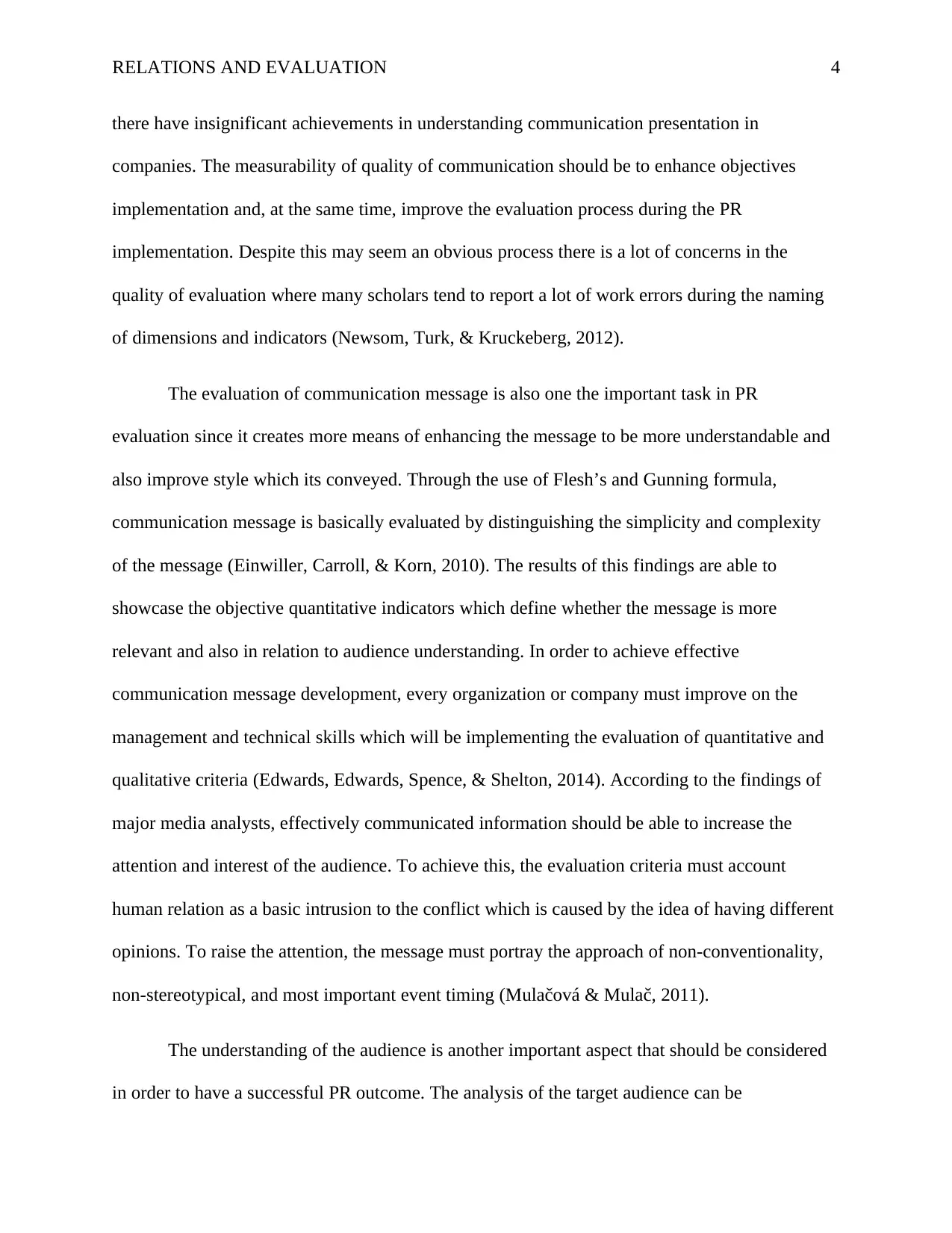
RELATIONS AND EVALUATION 4
there have insignificant achievements in understanding communication presentation in
companies. The measurability of quality of communication should be to enhance objectives
implementation and, at the same time, improve the evaluation process during the PR
implementation. Despite this may seem an obvious process there is a lot of concerns in the
quality of evaluation where many scholars tend to report a lot of work errors during the naming
of dimensions and indicators (Newsom, Turk, & Kruckeberg, 2012).
The evaluation of communication message is also one the important task in PR
evaluation since it creates more means of enhancing the message to be more understandable and
also improve style which its conveyed. Through the use of Flesh’s and Gunning formula,
communication message is basically evaluated by distinguishing the simplicity and complexity
of the message (Einwiller, Carroll, & Korn, 2010). The results of this findings are able to
showcase the objective quantitative indicators which define whether the message is more
relevant and also in relation to audience understanding. In order to achieve effective
communication message development, every organization or company must improve on the
management and technical skills which will be implementing the evaluation of quantitative and
qualitative criteria (Edwards, Edwards, Spence, & Shelton, 2014). According to the findings of
major media analysts, effectively communicated information should be able to increase the
attention and interest of the audience. To achieve this, the evaluation criteria must account
human relation as a basic intrusion to the conflict which is caused by the idea of having different
opinions. To raise the attention, the message must portray the approach of non-conventionality,
non-stereotypical, and most important event timing (Mulačová & Mulač, 2011).
The understanding of the audience is another important aspect that should be considered
in order to have a successful PR outcome. The analysis of the target audience can be
there have insignificant achievements in understanding communication presentation in
companies. The measurability of quality of communication should be to enhance objectives
implementation and, at the same time, improve the evaluation process during the PR
implementation. Despite this may seem an obvious process there is a lot of concerns in the
quality of evaluation where many scholars tend to report a lot of work errors during the naming
of dimensions and indicators (Newsom, Turk, & Kruckeberg, 2012).
The evaluation of communication message is also one the important task in PR
evaluation since it creates more means of enhancing the message to be more understandable and
also improve style which its conveyed. Through the use of Flesh’s and Gunning formula,
communication message is basically evaluated by distinguishing the simplicity and complexity
of the message (Einwiller, Carroll, & Korn, 2010). The results of this findings are able to
showcase the objective quantitative indicators which define whether the message is more
relevant and also in relation to audience understanding. In order to achieve effective
communication message development, every organization or company must improve on the
management and technical skills which will be implementing the evaluation of quantitative and
qualitative criteria (Edwards, Edwards, Spence, & Shelton, 2014). According to the findings of
major media analysts, effectively communicated information should be able to increase the
attention and interest of the audience. To achieve this, the evaluation criteria must account
human relation as a basic intrusion to the conflict which is caused by the idea of having different
opinions. To raise the attention, the message must portray the approach of non-conventionality,
non-stereotypical, and most important event timing (Mulačová & Mulač, 2011).
The understanding of the audience is another important aspect that should be considered
in order to have a successful PR outcome. The analysis of the target audience can be
Paraphrase This Document
Need a fresh take? Get an instant paraphrase of this document with our AI Paraphraser
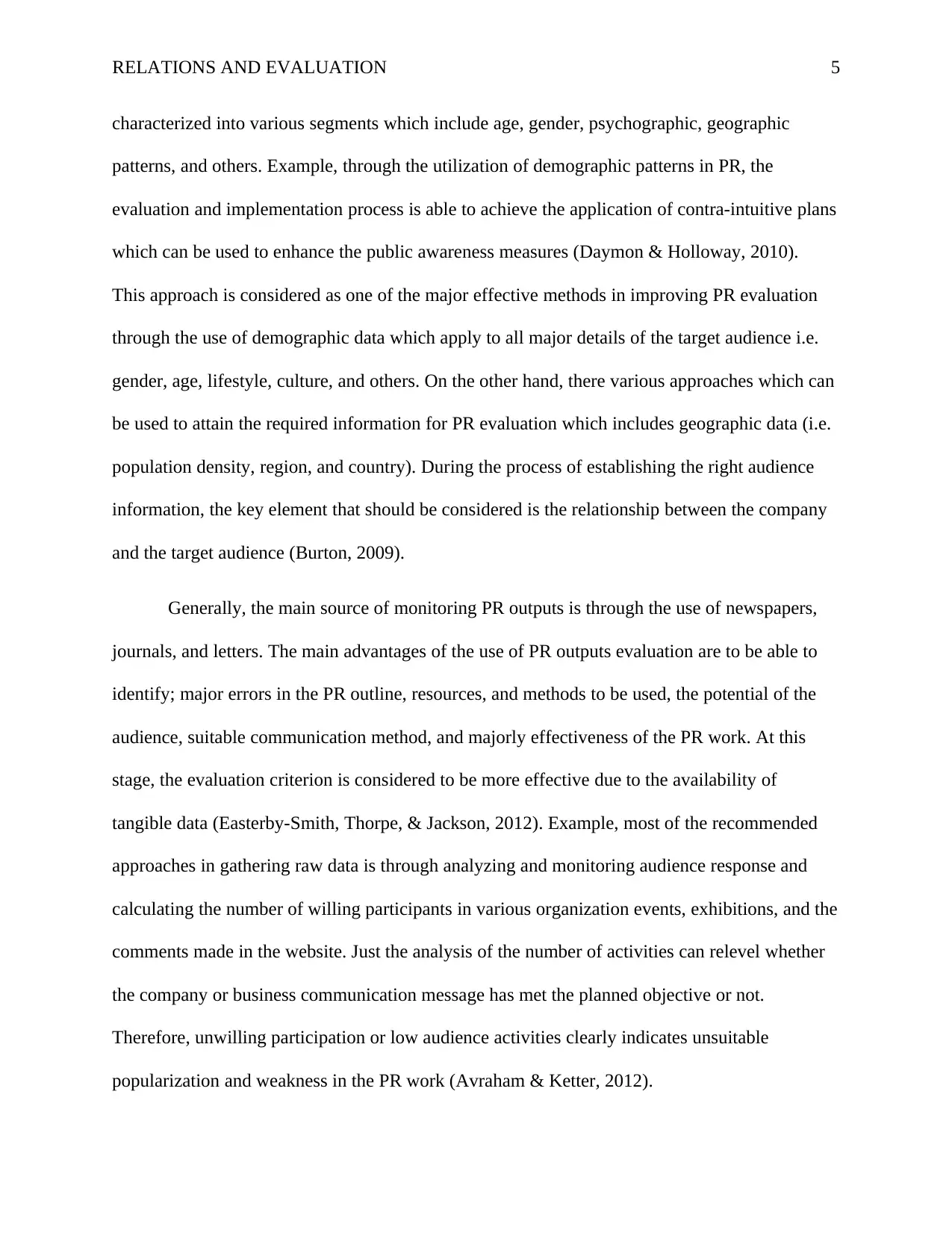
RELATIONS AND EVALUATION 5
characterized into various segments which include age, gender, psychographic, geographic
patterns, and others. Example, through the utilization of demographic patterns in PR, the
evaluation and implementation process is able to achieve the application of contra-intuitive plans
which can be used to enhance the public awareness measures (Daymon & Holloway, 2010).
This approach is considered as one of the major effective methods in improving PR evaluation
through the use of demographic data which apply to all major details of the target audience i.e.
gender, age, lifestyle, culture, and others. On the other hand, there various approaches which can
be used to attain the required information for PR evaluation which includes geographic data (i.e.
population density, region, and country). During the process of establishing the right audience
information, the key element that should be considered is the relationship between the company
and the target audience (Burton, 2009).
Generally, the main source of monitoring PR outputs is through the use of newspapers,
journals, and letters. The main advantages of the use of PR outputs evaluation are to be able to
identify; major errors in the PR outline, resources, and methods to be used, the potential of the
audience, suitable communication method, and majorly effectiveness of the PR work. At this
stage, the evaluation criterion is considered to be more effective due to the availability of
tangible data (Easterby-Smith, Thorpe, & Jackson, 2012). Example, most of the recommended
approaches in gathering raw data is through analyzing and monitoring audience response and
calculating the number of willing participants in various organization events, exhibitions, and the
comments made in the website. Just the analysis of the number of activities can relevel whether
the company or business communication message has met the planned objective or not.
Therefore, unwilling participation or low audience activities clearly indicates unsuitable
popularization and weakness in the PR work (Avraham & Ketter, 2012).
characterized into various segments which include age, gender, psychographic, geographic
patterns, and others. Example, through the utilization of demographic patterns in PR, the
evaluation and implementation process is able to achieve the application of contra-intuitive plans
which can be used to enhance the public awareness measures (Daymon & Holloway, 2010).
This approach is considered as one of the major effective methods in improving PR evaluation
through the use of demographic data which apply to all major details of the target audience i.e.
gender, age, lifestyle, culture, and others. On the other hand, there various approaches which can
be used to attain the required information for PR evaluation which includes geographic data (i.e.
population density, region, and country). During the process of establishing the right audience
information, the key element that should be considered is the relationship between the company
and the target audience (Burton, 2009).
Generally, the main source of monitoring PR outputs is through the use of newspapers,
journals, and letters. The main advantages of the use of PR outputs evaluation are to be able to
identify; major errors in the PR outline, resources, and methods to be used, the potential of the
audience, suitable communication method, and majorly effectiveness of the PR work. At this
stage, the evaluation criterion is considered to be more effective due to the availability of
tangible data (Easterby-Smith, Thorpe, & Jackson, 2012). Example, most of the recommended
approaches in gathering raw data is through analyzing and monitoring audience response and
calculating the number of willing participants in various organization events, exhibitions, and the
comments made in the website. Just the analysis of the number of activities can relevel whether
the company or business communication message has met the planned objective or not.
Therefore, unwilling participation or low audience activities clearly indicates unsuitable
popularization and weakness in the PR work (Avraham & Ketter, 2012).
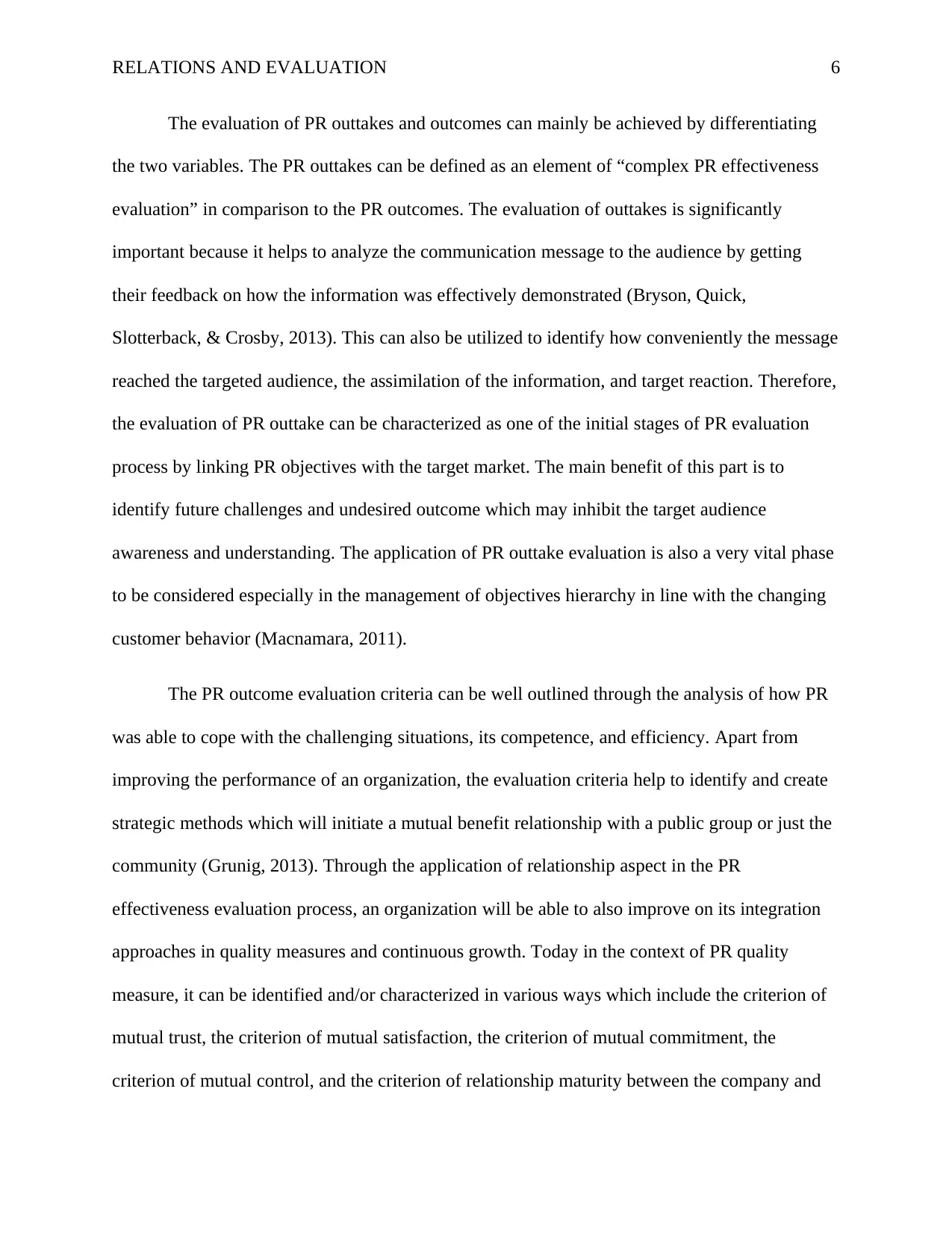
RELATIONS AND EVALUATION 6
The evaluation of PR outtakes and outcomes can mainly be achieved by differentiating
the two variables. The PR outtakes can be defined as an element of “complex PR effectiveness
evaluation” in comparison to the PR outcomes. The evaluation of outtakes is significantly
important because it helps to analyze the communication message to the audience by getting
their feedback on how the information was effectively demonstrated (Bryson, Quick,
Slotterback, & Crosby, 2013). This can also be utilized to identify how conveniently the message
reached the targeted audience, the assimilation of the information, and target reaction. Therefore,
the evaluation of PR outtake can be characterized as one of the initial stages of PR evaluation
process by linking PR objectives with the target market. The main benefit of this part is to
identify future challenges and undesired outcome which may inhibit the target audience
awareness and understanding. The application of PR outtake evaluation is also a very vital phase
to be considered especially in the management of objectives hierarchy in line with the changing
customer behavior (Macnamara, 2011).
The PR outcome evaluation criteria can be well outlined through the analysis of how PR
was able to cope with the challenging situations, its competence, and efficiency. Apart from
improving the performance of an organization, the evaluation criteria help to identify and create
strategic methods which will initiate a mutual benefit relationship with a public group or just the
community (Grunig, 2013). Through the application of relationship aspect in the PR
effectiveness evaluation process, an organization will be able to also improve on its integration
approaches in quality measures and continuous growth. Today in the context of PR quality
measure, it can be identified and/or characterized in various ways which include the criterion of
mutual trust, the criterion of mutual satisfaction, the criterion of mutual commitment, the
criterion of mutual control, and the criterion of relationship maturity between the company and
The evaluation of PR outtakes and outcomes can mainly be achieved by differentiating
the two variables. The PR outtakes can be defined as an element of “complex PR effectiveness
evaluation” in comparison to the PR outcomes. The evaluation of outtakes is significantly
important because it helps to analyze the communication message to the audience by getting
their feedback on how the information was effectively demonstrated (Bryson, Quick,
Slotterback, & Crosby, 2013). This can also be utilized to identify how conveniently the message
reached the targeted audience, the assimilation of the information, and target reaction. Therefore,
the evaluation of PR outtake can be characterized as one of the initial stages of PR evaluation
process by linking PR objectives with the target market. The main benefit of this part is to
identify future challenges and undesired outcome which may inhibit the target audience
awareness and understanding. The application of PR outtake evaluation is also a very vital phase
to be considered especially in the management of objectives hierarchy in line with the changing
customer behavior (Macnamara, 2011).
The PR outcome evaluation criteria can be well outlined through the analysis of how PR
was able to cope with the challenging situations, its competence, and efficiency. Apart from
improving the performance of an organization, the evaluation criteria help to identify and create
strategic methods which will initiate a mutual benefit relationship with a public group or just the
community (Grunig, 2013). Through the application of relationship aspect in the PR
effectiveness evaluation process, an organization will be able to also improve on its integration
approaches in quality measures and continuous growth. Today in the context of PR quality
measure, it can be identified and/or characterized in various ways which include the criterion of
mutual trust, the criterion of mutual satisfaction, the criterion of mutual commitment, the
criterion of mutual control, and the criterion of relationship maturity between the company and
⊘ This is a preview!⊘
Do you want full access?
Subscribe today to unlock all pages.

Trusted by 1+ million students worldwide
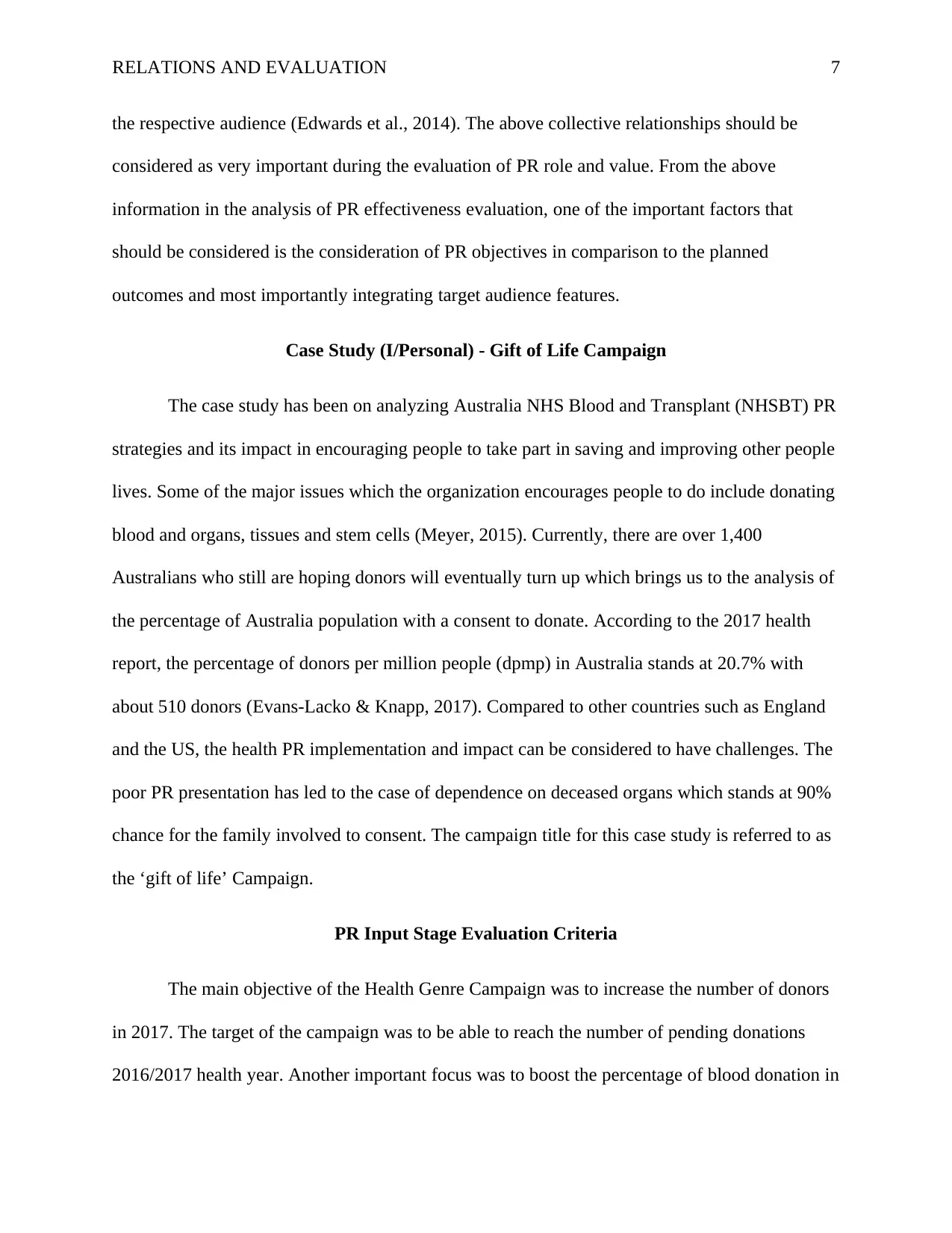
RELATIONS AND EVALUATION 7
the respective audience (Edwards et al., 2014). The above collective relationships should be
considered as very important during the evaluation of PR role and value. From the above
information in the analysis of PR effectiveness evaluation, one of the important factors that
should be considered is the consideration of PR objectives in comparison to the planned
outcomes and most importantly integrating target audience features.
Case Study (I/Personal) - Gift of Life Campaign
The case study has been on analyzing Australia NHS Blood and Transplant (NHSBT) PR
strategies and its impact in encouraging people to take part in saving and improving other people
lives. Some of the major issues which the organization encourages people to do include donating
blood and organs, tissues and stem cells (Meyer, 2015). Currently, there are over 1,400
Australians who still are hoping donors will eventually turn up which brings us to the analysis of
the percentage of Australia population with a consent to donate. According to the 2017 health
report, the percentage of donors per million people (dpmp) in Australia stands at 20.7% with
about 510 donors (Evans-Lacko & Knapp, 2017). Compared to other countries such as England
and the US, the health PR implementation and impact can be considered to have challenges. The
poor PR presentation has led to the case of dependence on deceased organs which stands at 90%
chance for the family involved to consent. The campaign title for this case study is referred to as
the ‘gift of life’ Campaign.
PR Input Stage Evaluation Criteria
The main objective of the Health Genre Campaign was to increase the number of donors
in 2017. The target of the campaign was to be able to reach the number of pending donations
2016/2017 health year. Another important focus was to boost the percentage of blood donation in
the respective audience (Edwards et al., 2014). The above collective relationships should be
considered as very important during the evaluation of PR role and value. From the above
information in the analysis of PR effectiveness evaluation, one of the important factors that
should be considered is the consideration of PR objectives in comparison to the planned
outcomes and most importantly integrating target audience features.
Case Study (I/Personal) - Gift of Life Campaign
The case study has been on analyzing Australia NHS Blood and Transplant (NHSBT) PR
strategies and its impact in encouraging people to take part in saving and improving other people
lives. Some of the major issues which the organization encourages people to do include donating
blood and organs, tissues and stem cells (Meyer, 2015). Currently, there are over 1,400
Australians who still are hoping donors will eventually turn up which brings us to the analysis of
the percentage of Australia population with a consent to donate. According to the 2017 health
report, the percentage of donors per million people (dpmp) in Australia stands at 20.7% with
about 510 donors (Evans-Lacko & Knapp, 2017). Compared to other countries such as England
and the US, the health PR implementation and impact can be considered to have challenges. The
poor PR presentation has led to the case of dependence on deceased organs which stands at 90%
chance for the family involved to consent. The campaign title for this case study is referred to as
the ‘gift of life’ Campaign.
PR Input Stage Evaluation Criteria
The main objective of the Health Genre Campaign was to increase the number of donors
in 2017. The target of the campaign was to be able to reach the number of pending donations
2016/2017 health year. Another important focus was to boost the percentage of blood donation in
Paraphrase This Document
Need a fresh take? Get an instant paraphrase of this document with our AI Paraphraser
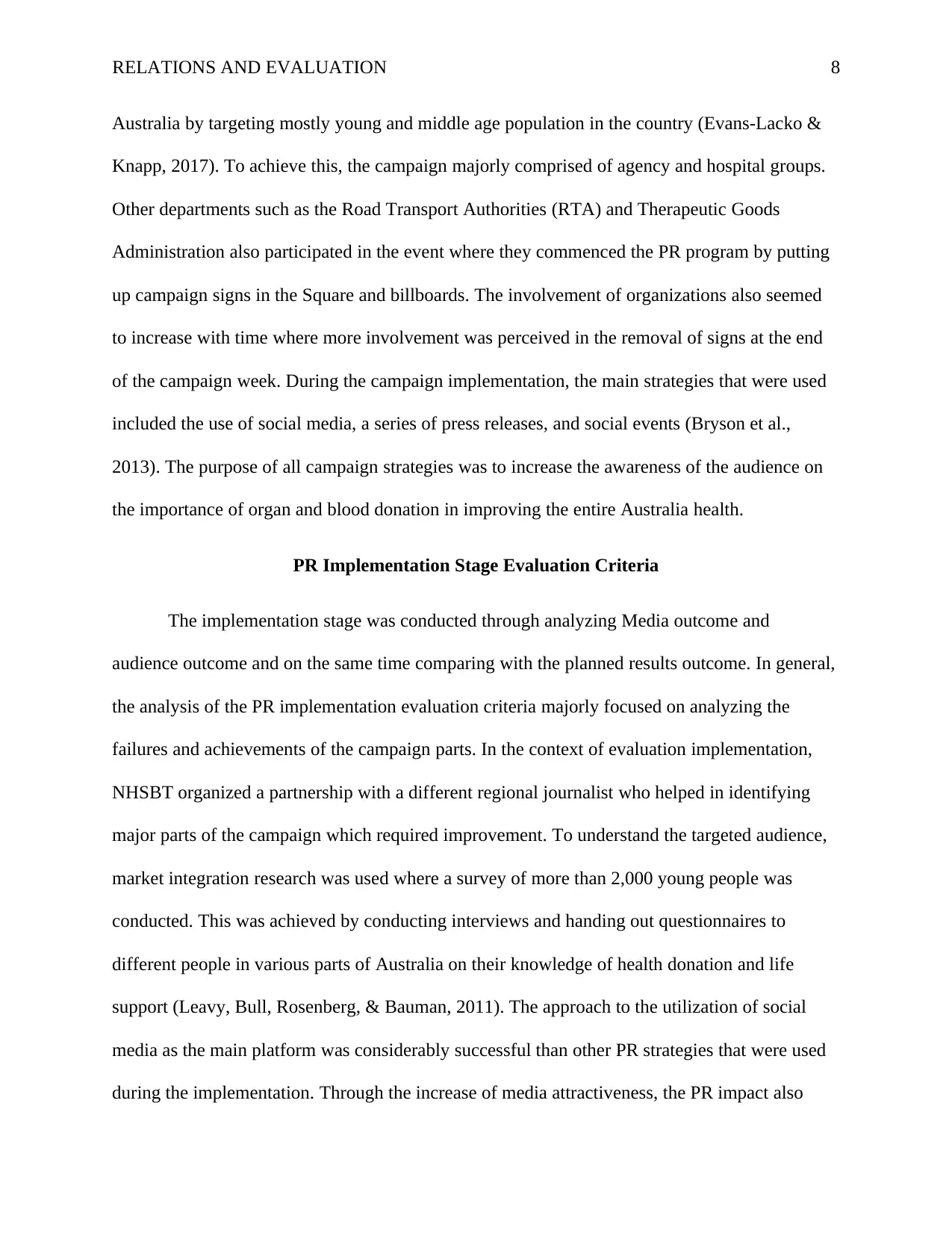
RELATIONS AND EVALUATION 8
Australia by targeting mostly young and middle age population in the country (Evans-Lacko &
Knapp, 2017). To achieve this, the campaign majorly comprised of agency and hospital groups.
Other departments such as the Road Transport Authorities (RTA) and Therapeutic Goods
Administration also participated in the event where they commenced the PR program by putting
up campaign signs in the Square and billboards. The involvement of organizations also seemed
to increase with time where more involvement was perceived in the removal of signs at the end
of the campaign week. During the campaign implementation, the main strategies that were used
included the use of social media, a series of press releases, and social events (Bryson et al.,
2013). The purpose of all campaign strategies was to increase the awareness of the audience on
the importance of organ and blood donation in improving the entire Australia health.
PR Implementation Stage Evaluation Criteria
The implementation stage was conducted through analyzing Media outcome and
audience outcome and on the same time comparing with the planned results outcome. In general,
the analysis of the PR implementation evaluation criteria majorly focused on analyzing the
failures and achievements of the campaign parts. In the context of evaluation implementation,
NHSBT organized a partnership with a different regional journalist who helped in identifying
major parts of the campaign which required improvement. To understand the targeted audience,
market integration research was used where a survey of more than 2,000 young people was
conducted. This was achieved by conducting interviews and handing out questionnaires to
different people in various parts of Australia on their knowledge of health donation and life
support (Leavy, Bull, Rosenberg, & Bauman, 2011). The approach to the utilization of social
media as the main platform was considerably successful than other PR strategies that were used
during the implementation. Through the increase of media attractiveness, the PR impact also
Australia by targeting mostly young and middle age population in the country (Evans-Lacko &
Knapp, 2017). To achieve this, the campaign majorly comprised of agency and hospital groups.
Other departments such as the Road Transport Authorities (RTA) and Therapeutic Goods
Administration also participated in the event where they commenced the PR program by putting
up campaign signs in the Square and billboards. The involvement of organizations also seemed
to increase with time where more involvement was perceived in the removal of signs at the end
of the campaign week. During the campaign implementation, the main strategies that were used
included the use of social media, a series of press releases, and social events (Bryson et al.,
2013). The purpose of all campaign strategies was to increase the awareness of the audience on
the importance of organ and blood donation in improving the entire Australia health.
PR Implementation Stage Evaluation Criteria
The implementation stage was conducted through analyzing Media outcome and
audience outcome and on the same time comparing with the planned results outcome. In general,
the analysis of the PR implementation evaluation criteria majorly focused on analyzing the
failures and achievements of the campaign parts. In the context of evaluation implementation,
NHSBT organized a partnership with a different regional journalist who helped in identifying
major parts of the campaign which required improvement. To understand the targeted audience,
market integration research was used where a survey of more than 2,000 young people was
conducted. This was achieved by conducting interviews and handing out questionnaires to
different people in various parts of Australia on their knowledge of health donation and life
support (Leavy, Bull, Rosenberg, & Bauman, 2011). The approach to the utilization of social
media as the main platform was considerably successful than other PR strategies that were used
during the implementation. Through the increase of media attractiveness, the PR impact also
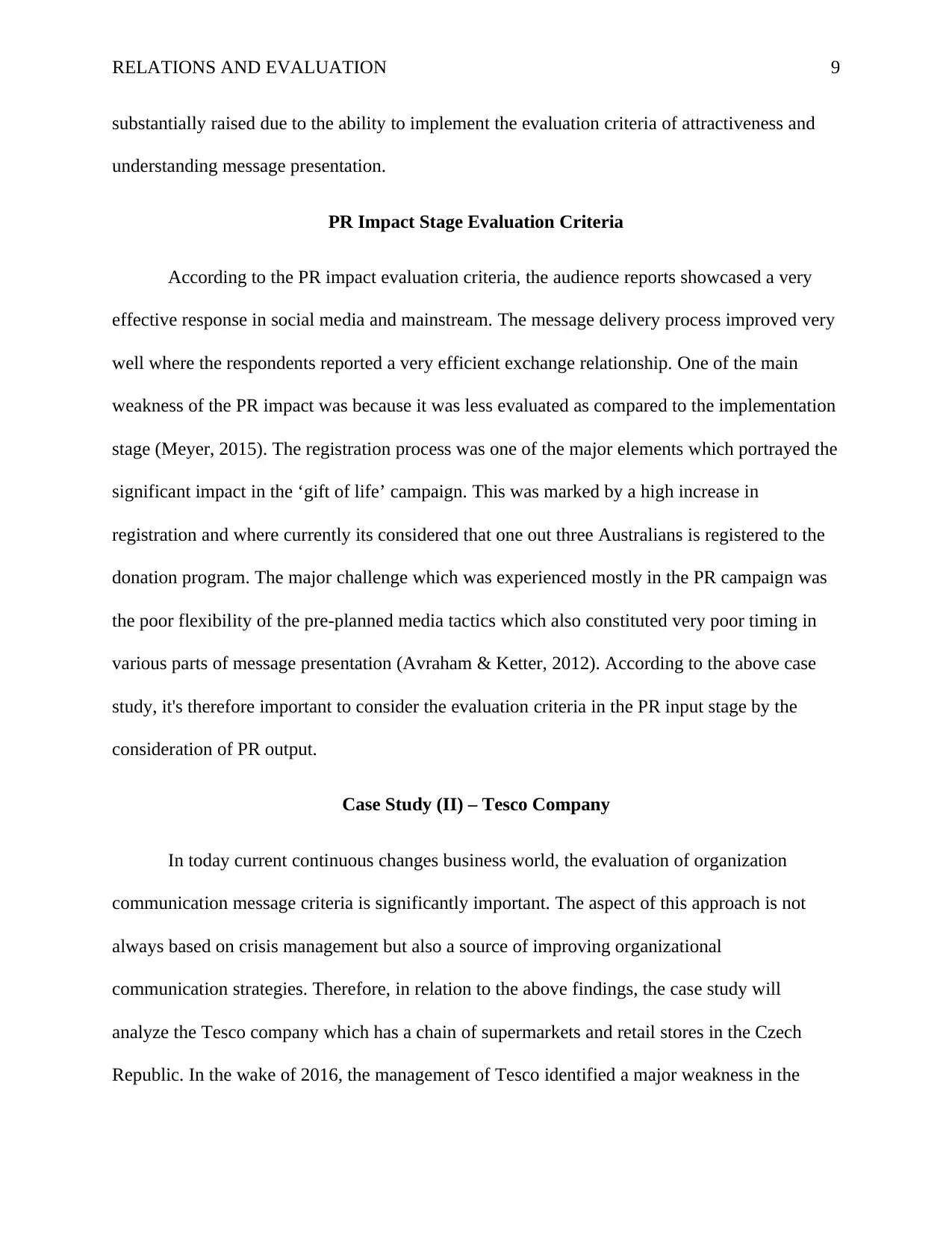
RELATIONS AND EVALUATION 9
substantially raised due to the ability to implement the evaluation criteria of attractiveness and
understanding message presentation.
PR Impact Stage Evaluation Criteria
According to the PR impact evaluation criteria, the audience reports showcased a very
effective response in social media and mainstream. The message delivery process improved very
well where the respondents reported a very efficient exchange relationship. One of the main
weakness of the PR impact was because it was less evaluated as compared to the implementation
stage (Meyer, 2015). The registration process was one of the major elements which portrayed the
significant impact in the ‘gift of life’ campaign. This was marked by a high increase in
registration and where currently its considered that one out three Australians is registered to the
donation program. The major challenge which was experienced mostly in the PR campaign was
the poor flexibility of the pre-planned media tactics which also constituted very poor timing in
various parts of message presentation (Avraham & Ketter, 2012). According to the above case
study, it's therefore important to consider the evaluation criteria in the PR input stage by the
consideration of PR output.
Case Study (II) – Tesco Company
In today current continuous changes business world, the evaluation of organization
communication message criteria is significantly important. The aspect of this approach is not
always based on crisis management but also a source of improving organizational
communication strategies. Therefore, in relation to the above findings, the case study will
analyze the Tesco company which has a chain of supermarkets and retail stores in the Czech
Republic. In the wake of 2016, the management of Tesco identified a major weakness in the
substantially raised due to the ability to implement the evaluation criteria of attractiveness and
understanding message presentation.
PR Impact Stage Evaluation Criteria
According to the PR impact evaluation criteria, the audience reports showcased a very
effective response in social media and mainstream. The message delivery process improved very
well where the respondents reported a very efficient exchange relationship. One of the main
weakness of the PR impact was because it was less evaluated as compared to the implementation
stage (Meyer, 2015). The registration process was one of the major elements which portrayed the
significant impact in the ‘gift of life’ campaign. This was marked by a high increase in
registration and where currently its considered that one out three Australians is registered to the
donation program. The major challenge which was experienced mostly in the PR campaign was
the poor flexibility of the pre-planned media tactics which also constituted very poor timing in
various parts of message presentation (Avraham & Ketter, 2012). According to the above case
study, it's therefore important to consider the evaluation criteria in the PR input stage by the
consideration of PR output.
Case Study (II) – Tesco Company
In today current continuous changes business world, the evaluation of organization
communication message criteria is significantly important. The aspect of this approach is not
always based on crisis management but also a source of improving organizational
communication strategies. Therefore, in relation to the above findings, the case study will
analyze the Tesco company which has a chain of supermarkets and retail stores in the Czech
Republic. In the wake of 2016, the management of Tesco identified a major weakness in the
⊘ This is a preview!⊘
Do you want full access?
Subscribe today to unlock all pages.

Trusted by 1+ million students worldwide
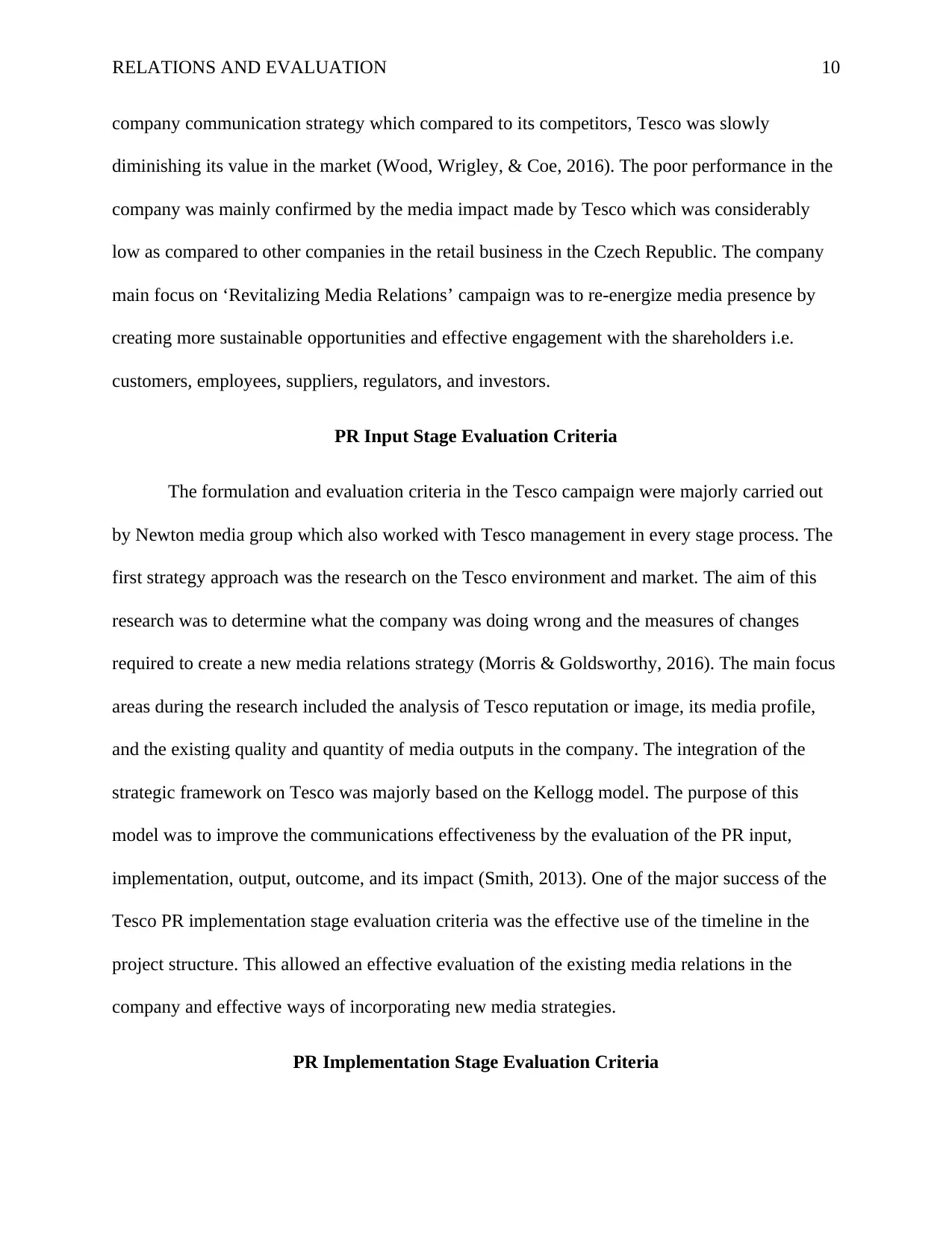
RELATIONS AND EVALUATION 10
company communication strategy which compared to its competitors, Tesco was slowly
diminishing its value in the market (Wood, Wrigley, & Coe, 2016). The poor performance in the
company was mainly confirmed by the media impact made by Tesco which was considerably
low as compared to other companies in the retail business in the Czech Republic. The company
main focus on ‘Revitalizing Media Relations’ campaign was to re-energize media presence by
creating more sustainable opportunities and effective engagement with the shareholders i.e.
customers, employees, suppliers, regulators, and investors.
PR Input Stage Evaluation Criteria
The formulation and evaluation criteria in the Tesco campaign were majorly carried out
by Newton media group which also worked with Tesco management in every stage process. The
first strategy approach was the research on the Tesco environment and market. The aim of this
research was to determine what the company was doing wrong and the measures of changes
required to create a new media relations strategy (Morris & Goldsworthy, 2016). The main focus
areas during the research included the analysis of Tesco reputation or image, its media profile,
and the existing quality and quantity of media outputs in the company. The integration of the
strategic framework on Tesco was majorly based on the Kellogg model. The purpose of this
model was to improve the communications effectiveness by the evaluation of the PR input,
implementation, output, outcome, and its impact (Smith, 2013). One of the major success of the
Tesco PR implementation stage evaluation criteria was the effective use of the timeline in the
project structure. This allowed an effective evaluation of the existing media relations in the
company and effective ways of incorporating new media strategies.
PR Implementation Stage Evaluation Criteria
company communication strategy which compared to its competitors, Tesco was slowly
diminishing its value in the market (Wood, Wrigley, & Coe, 2016). The poor performance in the
company was mainly confirmed by the media impact made by Tesco which was considerably
low as compared to other companies in the retail business in the Czech Republic. The company
main focus on ‘Revitalizing Media Relations’ campaign was to re-energize media presence by
creating more sustainable opportunities and effective engagement with the shareholders i.e.
customers, employees, suppliers, regulators, and investors.
PR Input Stage Evaluation Criteria
The formulation and evaluation criteria in the Tesco campaign were majorly carried out
by Newton media group which also worked with Tesco management in every stage process. The
first strategy approach was the research on the Tesco environment and market. The aim of this
research was to determine what the company was doing wrong and the measures of changes
required to create a new media relations strategy (Morris & Goldsworthy, 2016). The main focus
areas during the research included the analysis of Tesco reputation or image, its media profile,
and the existing quality and quantity of media outputs in the company. The integration of the
strategic framework on Tesco was majorly based on the Kellogg model. The purpose of this
model was to improve the communications effectiveness by the evaluation of the PR input,
implementation, output, outcome, and its impact (Smith, 2013). One of the major success of the
Tesco PR implementation stage evaluation criteria was the effective use of the timeline in the
project structure. This allowed an effective evaluation of the existing media relations in the
company and effective ways of incorporating new media strategies.
PR Implementation Stage Evaluation Criteria
Paraphrase This Document
Need a fresh take? Get an instant paraphrase of this document with our AI Paraphraser
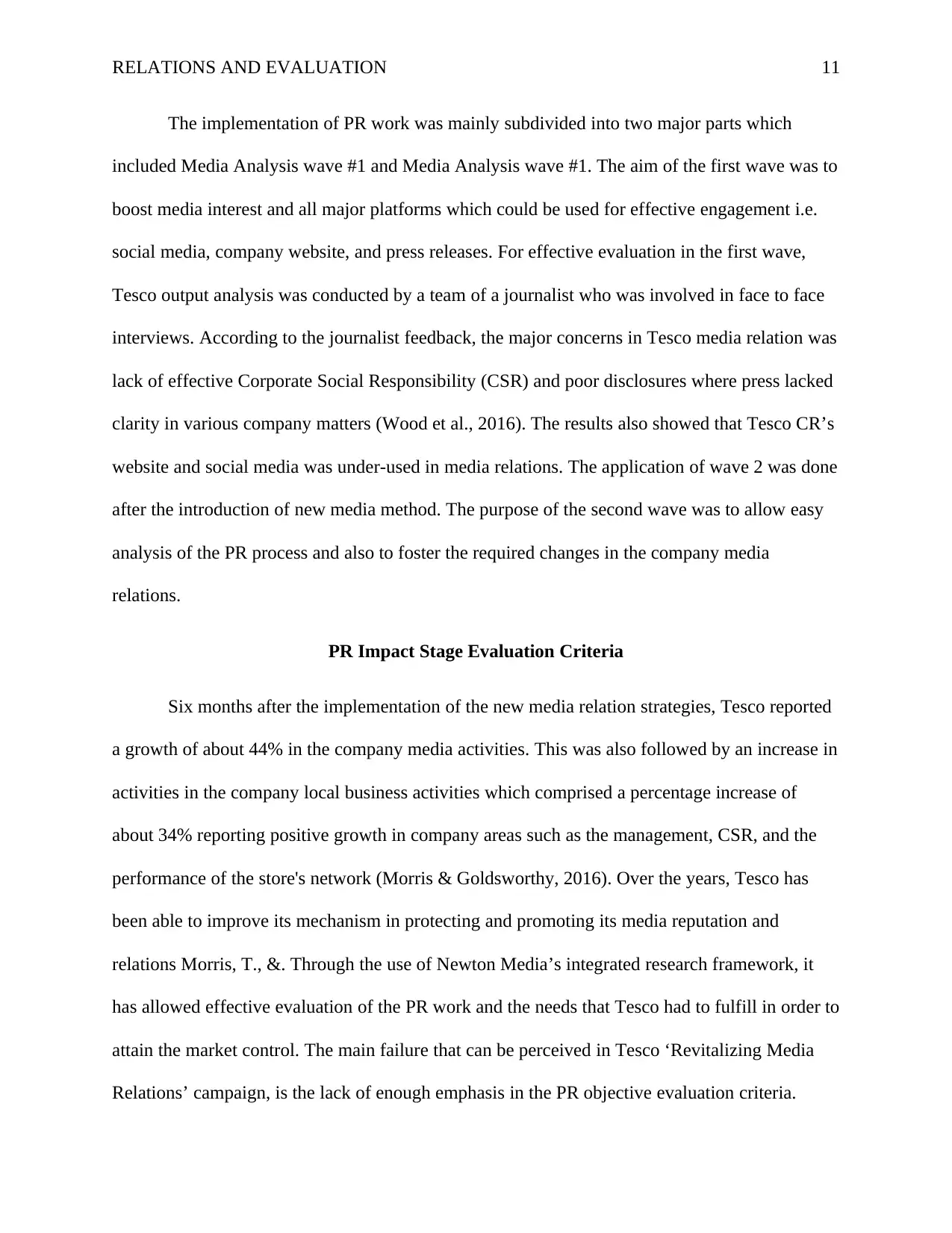
RELATIONS AND EVALUATION 11
The implementation of PR work was mainly subdivided into two major parts which
included Media Analysis wave #1 and Media Analysis wave #1. The aim of the first wave was to
boost media interest and all major platforms which could be used for effective engagement i.e.
social media, company website, and press releases. For effective evaluation in the first wave,
Tesco output analysis was conducted by a team of a journalist who was involved in face to face
interviews. According to the journalist feedback, the major concerns in Tesco media relation was
lack of effective Corporate Social Responsibility (CSR) and poor disclosures where press lacked
clarity in various company matters (Wood et al., 2016). The results also showed that Tesco CR’s
website and social media was under-used in media relations. The application of wave 2 was done
after the introduction of new media method. The purpose of the second wave was to allow easy
analysis of the PR process and also to foster the required changes in the company media
relations.
PR Impact Stage Evaluation Criteria
Six months after the implementation of the new media relation strategies, Tesco reported
a growth of about 44% in the company media activities. This was also followed by an increase in
activities in the company local business activities which comprised a percentage increase of
about 34% reporting positive growth in company areas such as the management, CSR, and the
performance of the store's network (Morris & Goldsworthy, 2016). Over the years, Tesco has
been able to improve its mechanism in protecting and promoting its media reputation and
relations Morris, T., &. Through the use of Newton Media’s integrated research framework, it
has allowed effective evaluation of the PR work and the needs that Tesco had to fulfill in order to
attain the market control. The main failure that can be perceived in Tesco ‘Revitalizing Media
Relations’ campaign, is the lack of enough emphasis in the PR objective evaluation criteria.
The implementation of PR work was mainly subdivided into two major parts which
included Media Analysis wave #1 and Media Analysis wave #1. The aim of the first wave was to
boost media interest and all major platforms which could be used for effective engagement i.e.
social media, company website, and press releases. For effective evaluation in the first wave,
Tesco output analysis was conducted by a team of a journalist who was involved in face to face
interviews. According to the journalist feedback, the major concerns in Tesco media relation was
lack of effective Corporate Social Responsibility (CSR) and poor disclosures where press lacked
clarity in various company matters (Wood et al., 2016). The results also showed that Tesco CR’s
website and social media was under-used in media relations. The application of wave 2 was done
after the introduction of new media method. The purpose of the second wave was to allow easy
analysis of the PR process and also to foster the required changes in the company media
relations.
PR Impact Stage Evaluation Criteria
Six months after the implementation of the new media relation strategies, Tesco reported
a growth of about 44% in the company media activities. This was also followed by an increase in
activities in the company local business activities which comprised a percentage increase of
about 34% reporting positive growth in company areas such as the management, CSR, and the
performance of the store's network (Morris & Goldsworthy, 2016). Over the years, Tesco has
been able to improve its mechanism in protecting and promoting its media reputation and
relations Morris, T., &. Through the use of Newton Media’s integrated research framework, it
has allowed effective evaluation of the PR work and the needs that Tesco had to fulfill in order to
attain the market control. The main failure that can be perceived in Tesco ‘Revitalizing Media
Relations’ campaign, is the lack of enough emphasis in the PR objective evaluation criteria.
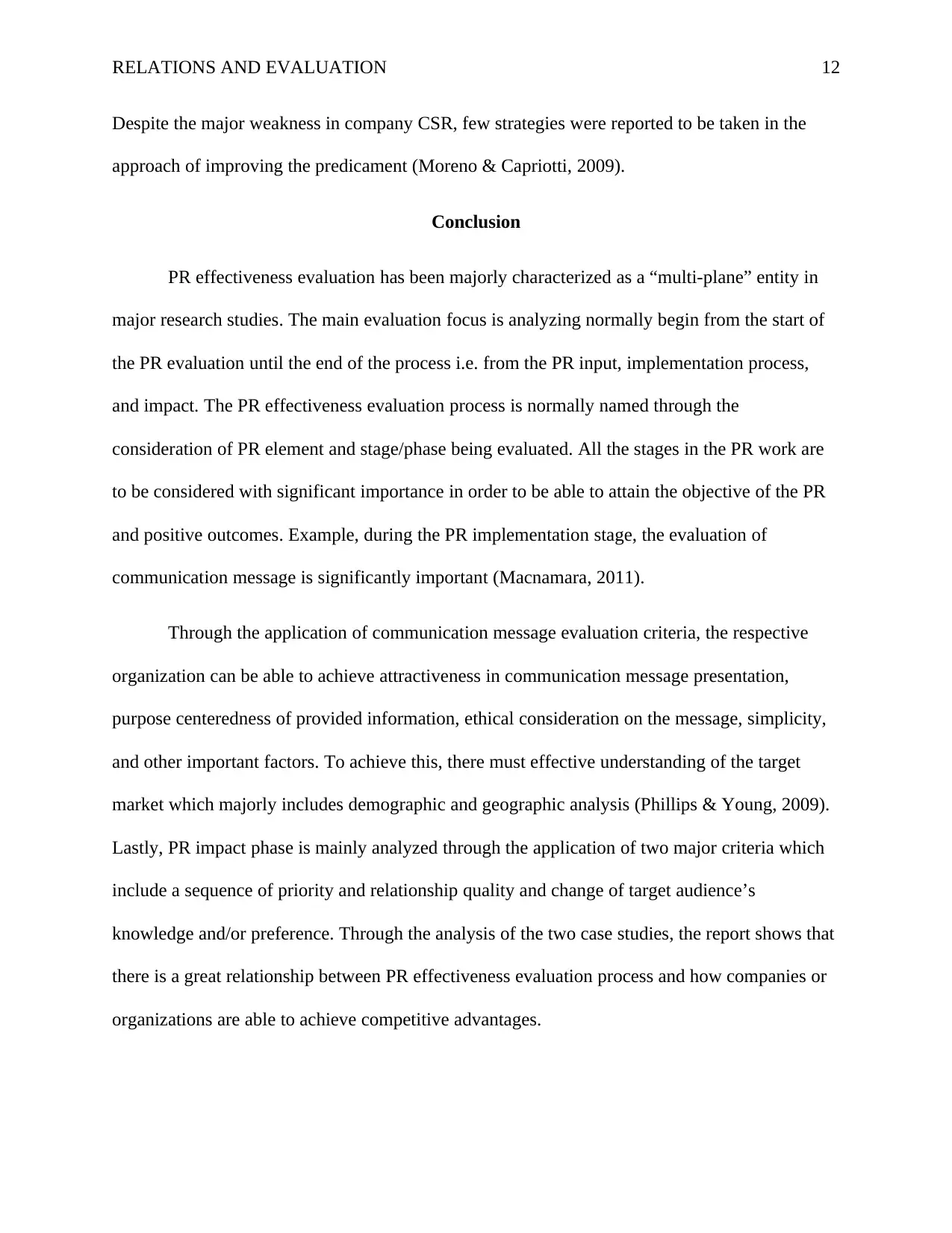
RELATIONS AND EVALUATION 12
Despite the major weakness in company CSR, few strategies were reported to be taken in the
approach of improving the predicament (Moreno & Capriotti, 2009).
Conclusion
PR effectiveness evaluation has been majorly characterized as a “multi-plane” entity in
major research studies. The main evaluation focus is analyzing normally begin from the start of
the PR evaluation until the end of the process i.e. from the PR input, implementation process,
and impact. The PR effectiveness evaluation process is normally named through the
consideration of PR element and stage/phase being evaluated. All the stages in the PR work are
to be considered with significant importance in order to be able to attain the objective of the PR
and positive outcomes. Example, during the PR implementation stage, the evaluation of
communication message is significantly important (Macnamara, 2011).
Through the application of communication message evaluation criteria, the respective
organization can be able to achieve attractiveness in communication message presentation,
purpose centeredness of provided information, ethical consideration on the message, simplicity,
and other important factors. To achieve this, there must effective understanding of the target
market which majorly includes demographic and geographic analysis (Phillips & Young, 2009).
Lastly, PR impact phase is mainly analyzed through the application of two major criteria which
include a sequence of priority and relationship quality and change of target audience’s
knowledge and/or preference. Through the analysis of the two case studies, the report shows that
there is a great relationship between PR effectiveness evaluation process and how companies or
organizations are able to achieve competitive advantages.
Despite the major weakness in company CSR, few strategies were reported to be taken in the
approach of improving the predicament (Moreno & Capriotti, 2009).
Conclusion
PR effectiveness evaluation has been majorly characterized as a “multi-plane” entity in
major research studies. The main evaluation focus is analyzing normally begin from the start of
the PR evaluation until the end of the process i.e. from the PR input, implementation process,
and impact. The PR effectiveness evaluation process is normally named through the
consideration of PR element and stage/phase being evaluated. All the stages in the PR work are
to be considered with significant importance in order to be able to attain the objective of the PR
and positive outcomes. Example, during the PR implementation stage, the evaluation of
communication message is significantly important (Macnamara, 2011).
Through the application of communication message evaluation criteria, the respective
organization can be able to achieve attractiveness in communication message presentation,
purpose centeredness of provided information, ethical consideration on the message, simplicity,
and other important factors. To achieve this, there must effective understanding of the target
market which majorly includes demographic and geographic analysis (Phillips & Young, 2009).
Lastly, PR impact phase is mainly analyzed through the application of two major criteria which
include a sequence of priority and relationship quality and change of target audience’s
knowledge and/or preference. Through the analysis of the two case studies, the report shows that
there is a great relationship between PR effectiveness evaluation process and how companies or
organizations are able to achieve competitive advantages.
⊘ This is a preview!⊘
Do you want full access?
Subscribe today to unlock all pages.

Trusted by 1+ million students worldwide
1 out of 15
Related Documents
Your All-in-One AI-Powered Toolkit for Academic Success.
+13062052269
info@desklib.com
Available 24*7 on WhatsApp / Email
![[object Object]](/_next/static/media/star-bottom.7253800d.svg)
Unlock your academic potential
Copyright © 2020–2025 A2Z Services. All Rights Reserved. Developed and managed by ZUCOL.




